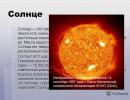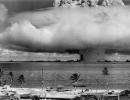Thermal phenomena presentation. Thermal phenomena. shape and volume
A review and generalization lesson in physics in grade 8 on the topic “Thermal Phenomena” can be diversified with the help of a presentation
"Thermal phenomena in nature", consisting of three sections: Thermal phenomena1, thermal phenomena2, thermal phenomena3.
Download:
Preview:
MKOU "Bolsheleushinskaya Secondary School"
Physics lesson in 8th grade
Lesson topic: Thermal phenomena in nature
Lesson objectives:
- In an interesting form, summarize and consolidate the knowledge acquired by students on the topic “Thermal phenomena. Aggregate states of matter. Phase transitions".
- To teach to see the manifestations of the studied patterns in the surrounding life, to teach students to apply knowledge in a new situation, to develop the ability to explain surrounding phenomena, to improve skills in solving qualitative problems, to broaden the horizons of students.
- Develop the ability to work in a team in combination with independent work, develop communication skills.
- To cultivate patriotic feelings and pride in the fact that the great scientist M.V. lived and worked in our country. Lomonosov, poets V. Bryusov, F. Tyutchev, P. Vyazemsky and other poets and writers who wrote poetry and prose about the nature of Russia.
Lesson type: repetitive - generalizing
Lesson methods: verbal, visual
Lesson structure:
- Organizing time. Announcing the goals and objectives of the lesson.
- Introduction to the lesson. Reading a poem by P. Vyazemsky.
- Updating students' knowledge on the topic (student presentation)
- Lesson summary. Reflection.
- Homework
During the classes:
Time | Expected result | Organizational forms | Teacher activities | Student activities |
|
2 minutes. | Organizational moment: conversation. (slide No. 1-4 of the teacher’s presentation) | Be familiar with the stages of a lesson | Frontal | Greets students; announces the topic of the lesson. | The teachers are greeted; listen, comprehend the lesson plan |
3 min. | Introduction to the lesson. (Slide No. 5 of the teacher's presentation) A student reading a poem by P. Vyazemsky. “Today the surrounding area has taken on a new look, | Listening to the poem, a better meaningful understanding of the topic of the lesson, goals and objectives of the lesson will come. | Individual, frontal | Together with students, he sets the goals and objectives of the lesson. | Discuss, comprehend. |
7 min | Updating students' knowledge on the topic(student presentation “Thermal Phenomena”) | They will repeat the physical meaning of the concepts: state of aggregation of matter; phenomena - thermal conductivity, convection, radiation; concept of phase transition; phenomena - melting, crystallization, evaporation, condensation; sublimation already familiar to students from previous lesson topics | Frontal | Together with students, provides assistance to students and answers questions that arise. | Look at slides No. 1-15 presentations, listen, help the student who prepared the presentation and ask him questions. |
25 min. | Solving qualitative problems and studying interesting additional material on the topic (Teacher presentation slides No. 7 - 40) | They will learn to see the manifestations of the studied patterns in life around them, they will learn to apply knowledge in a new situation, they will develop the ability to explain surrounding phenomena, improve their skills in solving qualitative problems, and broaden their horizons. | Frontal | Uses multimedia equipment and a computer. Asks questions to students and shows these questions in the presentation. After students answer a question, the teacher shows a slide with the answer. Reads additional material “In the world of interesting things” | They listen, comprehend, draw conclusions, ask questions, and answer orally the teacher’s questions from the presentation. Students read the correct answer on the presentation slide. |
3 min. | Lesson summary. Reflection. Homework (Teacher presentation slide No. 41-42) “In all centuries there has lived, hidden, the hope of revealing all the mysteries of nature” V.Ya. Bryusov | Summarize and systematize knowledge on the topic “Thermal Phenomena” Write down your homework. Get an idea of how to complete your homework. | Frontal Individual | Gives instructions for generalizing and systematizing knowledge, determines together with students whether the goals of the lesson have been achieved. In what mood do students leave the lesson? Gives instructions on how to do homework: repeat all the material on the topic; remember basic concepts; repeat formulas and look at previously solved problems of different types on this topic | They determine whether they have completed the tasks that were determined by them and the teacher at the beginning of the lesson. Determine your mood. Listen to instructions on how to do homework and write it down in your diary. Ask questions to clarify understanding and completion of homework. |
Slide captions:
Residents of the Far North use snow as a poor heat conductor to build very warm homes. These snow dwellings are called igloos. Inside, the walls of the home are covered with cloth and skins, deer skins are placed on the floor, and a fireplace is built for cooking food. Despite the very severe frosts (50-60 °C), the snow inside the room is as warm as an ordinary room.
... Here is a crow on a sloping roof, So it has remained shaggy since the winter And in the air there are spring bells Even the crow’s spirit has taken over... A. Block “Crow”: Why was the crow shaggy in winter?
Imagine putting a spoon into a glass of tea to stir sugar, and feeling the spoon quickly lose weight. You take it out of the glass, and you only have the very tip. The spoon melted. Could this be possible? Maybe. The production of low-melting alloys has now been mastered. One of them, consisting of indium, bismuth, tin and lead, melts at a temperature of 45 ° C, although none of the listed metals melts at this temperature. However, teaspoons are not stamped from this alloy. It is used in automatic devices and regulators that must monitor the slightest increase in temperature and immediately signal about it.
Santa Claus is known to do miracles. He can build a bridge on a river without an ax or a single nail, and he can turn water into ice. Using the power of frost, physicists can make air liquid and flowing like water. And then it can be poured from one vessel to another. If you lower a lead bell into liquid air, it will ring like a silver one. Alcohol cooled in it becomes solid. And no matter how much you light it with a match, it won’t light up! Soap exposed to liquid air turns yellow and... glows in the dark. And not only meat, but also bone, bread, eggshells, cotton wool, cooled with liquid air, also glow.
The Sun The Sun is the star closest to us. Thanks to him, there is life on Earth. It gives us light and warmth. The Sun is 109 times larger than our planet, its diameter is km. The mass of our daylight is almost 2·10 30 kg. The Sun does not have a solid surface; it is a hot ball of gas. The Sun is the star closest to us. Thanks to him, there is life on Earth. It gives us light and warmth. The Sun is 109 times larger than our planet, its diameter is km. The mass of our daylight is almost 2·10 30 kg. The Sun does not have a solid surface; it is a hot ball of gas. This ball consists mainly of hydrogen and helium. The temperature on its surface is about °C, in the center (in the core) °C. At this temperature, chemical reactions occur (they are called thermonuclear reactions), in which hydrogen is converted into helium, releasing a huge amount of energy. We can say that hydrogen is a fuel, the combustion of which provides energy that allows the Sun to shine and emit heat. This ball consists mainly of hydrogen and helium. The temperature on its surface is about °C, in the center (in the core) °C. At this temperature, chemical reactions occur (they are called thermonuclear reactions), in which hydrogen is converted into helium, releasing a huge amount of energy. We can say that hydrogen is a fuel, the combustion of which provides energy that allows the Sun to shine and emit heat. An image of the Sun taken on September 14, 1997 from the unmanned space observatory SOHO (USA).

Why is it that in many regions of our planet, warm summers are replaced by first cool autumns and then frosty winters? Why does the sun heat differently at different times of the year: on a hot summer afternoon you want to hide in the shade from the scorching rays of the sun, but during winter frosts you can freeze even on a fine day? Why is it that in many regions of our planet, warm summers are replaced by first cool autumns and then frosty winters? Why does the sun heat differently at different times of the year: on a hot summer afternoon you want to hide in the shade from the scorching rays of the sun, but during winter frosts you can freeze even on a fine day? This is explained by the fact that the Earth's orbit around the Sun is an ellipse. The earth's axis is inclined to the orbital plane at an angle of 66°33. That is, it turns out that for one half of the year the sun's rays fall more vertically and heat up the Northern Hemisphere more strongly, and for the other half of the year the Southern Hemisphere. Accordingly, summer begins in the hemisphere that is heated and illuminated by the Sun more. When it's summer in the Southern Hemisphere, people go skiing in the Northern Hemisphere. This is explained by the fact that the Earth's orbit around the Sun is an ellipse. The earth's axis is inclined to the orbital plane at an angle of 66°33. That is, it turns out that for one half of the year the sun's rays fall more vertically and heat up the Northern Hemisphere more strongly, and for the other half of the year the Southern Hemisphere. Accordingly, summer begins in the hemisphere that is heated and illuminated by the Sun more. When it's summer in the Southern Hemisphere, people go skiing in the Northern Hemisphere. Due to the curvature of the earth's surface, the energy of equal flows A and B is distributed over large areas, while the energy of flow B is concentrated on a smaller area, therefore, area B will be warmer than area A and B. The figure shows the position of the Earth on June 21, when the rays of the Sun fall vertically in the Northern Tropic.


Seasons: Fun Facts More than half the world's population has never seen snow, except in photographs. More than half the world's population has never seen snow, except in photographs. Spring moves at a speed of approximately 50 kilometers per day. This was determined by observing the inflorescence of individual plants. Spring moves at a speed of approximately 50 kilometers per day. This was determined by observing the inflorescence of individual plants.
The sun never illuminates the regions of the Earth's poles strongly enough; its rays seem to slide off the surface of the globe, so there are practically no differences between the seasons and eternal winter reigns. The sun never illuminates the regions of the Earth's poles strongly enough; its rays seem to slide off the surface of the globe, so there are practically no differences between the seasons and eternal winter reigns. At the equator, the seasons are also not too different from each other, only in these areas it is constantly hot and it rains often. This is due to the fact that at the equator, the sun's rays hit the Earth almost vertically all year round. At the equator, the seasons are also not too different from each other, only in these areas it is constantly hot and it rains often. This is due to the fact that at the equator, the sun's rays hit the Earth almost vertically all year round.
Solar-terrestrial connections The Earth is the third planet of the solar system, located at a distance of about 150 million km from the Sun, the Earth receives approximately one two-billionth of the energy emitted by it. The Earth is the third planet of the solar system, located at a distance of about 150 million km from the Sun. The Earth receives approximately one two-billionth of the energy emitted by it. Life on Earth would be impossible without liquid water and atmosphere. The atmosphere protects the Earth from harmful radiation from the Sun by allowing heat and light to pass through. Thanks to this, the Earth never gets too hot or cold. The processes of evaporation and condensation of water play an equally important role in the processes of global heat exchange. Life on Earth would be impossible without liquid water and atmosphere. The atmosphere protects the Earth from harmful radiation from the Sun by allowing heat and light to pass through. Thanks to this, the Earth never gets too hot or cold. The processes of evaporation and condensation of water play an equally important role in the processes of global heat exchange. View of the Sun from Earth

Earth's Atmosphere The Earth's atmosphere is a massive shell of air that rotates with it and consists mainly of nitrogen and oxygen. The lower 20 km contains water vapor (at the earth's surface from 3% in the tropics to 2·10 -5% in Antarctica), the amount of which quickly decreases with height. The unevenness of its heating contributes to the general circulation of the atmosphere, which affects the weather and climate of the Earth. The Earth's atmosphere is a massive shell of air that rotates with it and consists mainly of nitrogen and oxygen. The lower 20 km contains water vapor (at the earth's surface from 3% in the tropics to 2·10 -5% in Antarctica), the amount of which quickly decreases with height. The unevenness of its heating contributes to the general circulation of the atmosphere, which affects the weather and climate of the Earth. Moisture circulation and phase transformations of water take place in the atmosphere, and air masses move. Moisture circulation and phase transformations of water take place in the atmosphere, and air masses move. This is what the earth's atmosphere looks like from space. It protects us from cosmic cold and many types of solar radiation, letting through only that which is useful to us: heat and light. The atmosphere consists of various gases, but most of all it contains nitrogen and oxygen, and noticeably less carbon dioxide. Such conditions on Earth ensure the existence of living organisms.
Warming the Atmosphere from Above Water vapor and carbon dioxide present in the atmosphere allow visible radiation from the Sun to pass through, but absorb infrared (thermal) radiation, so the atmosphere is heated from above. Thermal energy accumulates mainly in the lower layers of the atmosphere. A similar effect occurs in a greenhouse when glass allows light to enter and the soil heats up. The heating of the lower atmosphere due to the presence of water vapor and carbon dioxide is often called the greenhouse effect. Water vapor and carbon dioxide present in the atmosphere allow visible radiation from the sun to pass through, but absorb infrared (thermal) radiation, so the atmosphere is heated from above. Thermal energy accumulates mainly in the lower layers of the atmosphere. A similar effect occurs in a greenhouse when glass allows light to enter and the soil heats up. The heating of the lower atmosphere due to the presence of water vapor and carbon dioxide is often called the greenhouse effect. It has been established that the natural greenhouse effect currently ensures that the average temperature on the Earth's surface is 33° C higher than what would be observed in the absence of atmospheric cover. It has been established that the natural greenhouse effect currently ensures that the average temperature on the Earth's surface is 33° C higher than what would be observed in the absence of atmospheric cover.
Heating the atmosphere from below Water located on the surface of the Earth absorbs solar energy and evaporates, turning into gas - water vapor, which, rising upward due to convection, carries a huge amount of energy into the lower layers of the atmosphere. When water vapor condenses and clouds or fog form, this energy is released as heat. About half of the solar energy reaching the earth's surface is spent on water evaporation and also enters the lower layers of the atmosphere. Water located on the surface of the Earth absorbs solar energy and evaporates, turning into gas - water vapor, which, rising upward due to convection, carries a huge amount of energy into the lower layers of the atmosphere. When water vapor condenses and clouds or fog form, this energy is released as heat. About half of the solar energy reaching the earth's surface is spent on water evaporation and also enters the lower layers of the atmosphere. Cloudiness plays a significant role in maintaining heat in the lower layers of the atmosphere: if the clouds dissipate, the temperature inevitably drops as the Earth's surface freely radiates thermal energy into the surrounding space. Cloudiness plays a significant role in maintaining heat in the lower layers of the atmosphere: if the clouds dissipate, the temperature inevitably drops as the Earth's surface freely radiates thermal energy into the surrounding space.
Thermal phenomena in nature Since the temperature of the earth's surface is usually not equal to the temperature of the air above it, heat exchange occurs between the earth's surface and the atmosphere, as well as between the earth's surface and the deeper layers of the lithosphere or hydrosphere. The World Ocean is a powerful heat accumulator and regulator of the Earth's thermal regime. If there were no ocean, the average temperature of the Earth's surface would be -21 ° C, that is, it would be 36 ° lower than what it actually is. Since the temperature of the earth's surface is usually not equal to the temperature of the air above it, heat exchange occurs between the earth's surface and the atmosphere, as well as between the earth's surface and the deeper layers of the lithosphere or hydrosphere. The World Ocean is a powerful heat accumulator and regulator of the Earth's thermal regime. If there were no ocean, the average temperature of the Earth's surface would be -21 ° C, that is, it would be 36 ° lower than what it actually is. As a result of energy exchange between the Sun, Earth and the atmosphere, not only processes of energy transfer from more heated bodies to less heated ones occur on a gigantic scale, but also phase transformations: evaporation and condensation, melting and crystallization, sublimation. As a result of energy exchange between the Sun, Earth and the atmosphere, not only processes of energy transfer from more heated bodies to less heated ones occur on a gigantic scale, but also phase transformations: evaporation and condensation, melting and crystallization, sublimation.
Thermal balance of the Earth As a result of a complex energy exchange between the earth's surface, atmosphere and interplanetary space, each of these components receives on average as much energy from the other two as it loses itself. Consequently, neither the earth's surface nor the atmosphere experiences any increase or decrease in energy: the law of conservation of energy works here. As a result of complex energy exchange between the earth's surface, atmosphere and interplanetary space, each of these components receives on average as much energy from the other two as it loses itself. Consequently, neither the earth's surface nor the atmosphere experiences any increase or decrease in energy: the law of conservation of energy works here.
Over the past hundred years, the air temperature on the planet has increased by about half a degree, which most scientists associate with the “greenhouse effect” of technogenic origin. However, there were also significant climate fluctuations, in particular warming in the 1940s and cooling in the 1960s. It is very difficult to predict what the climate will be like in the coming decades, since the overall increase in temperature on Earth is determined by many interrelated factors. Over the past hundred years, the air temperature on the planet has increased by about half a degree, which most scientists associate with the “greenhouse effect” of technogenic origin. However, there were also significant climate fluctuations, in particular warming in the 1940s and cooling in the 1960s. It is very difficult to predict what the climate will be like in the coming decades, since the overall increase in temperature on Earth is determined by many interrelated factors. Nature in numbers The hottest place in the world is Death Valley in California, USA. Temperatures above 49 °C remained here for 43 days in a row. And the coldest places in the world are not geographic poles at all, but the so-called poles of cold. This is Oymyakon in Yakutia and the area in Antarctica near the Vostok scientific station. There the frost reaches -89 °C. And the average temperature of the coldest month of January is about -50 °C. The hottest place in the world is Death Valley in California, USA. Temperatures above 49 °C remained here for 43 days in a row. And the coldest places in the world are not geographic poles at all, but the so-called poles of cold. This is Oymyakon in Yakutia and the area in Antarctica near the Vostok scientific station. There the frost reaches -89 °C. And the average temperature of the coldest month of January is about -50 °C.

Information resources used Children's Encyclopedia of Cyril and Methodius 2006 (2CD) Children's Encyclopedia of Cyril and Methodius 2006 (2CD) Big Encyclopedia 2008 (3CD) Big Encyclopedia 2008 (3CD) Illustrated Encyclopedic Dictionary on CD, etc. Illustrated Encyclopedic Dictionary on CD, etc. .
Internal energy and ways of changing it Internal energy is the energy of movement and interaction of the particles that make up the body. Methods of changing internal energy, doing work, heat transfer over a body, the body itself, thermal conductivity, convection, radiation, E increases, E decreases

Heat transfer Heat conduction is a type of heat exchange in which internal energy is transferred from particles of a more heated part of the body to particles of a less heated part of the body (or from a more heated body to a less heated body). Convection is the transfer of energy by flows (or jets) of matter. Radiation is the transfer of energy using various invisible rays emitted by a heated body.
Quantity of heat Quantity of heat (Q) is the energy that a body receives or gives off during the process of heat transfer. Specific heat capacity (c) is the amount of heat required to heat 1 kg of a substance by 1°C. Unit of measurement – J/kg°C. The formula for calculating the amount of heat required to heat a body and released by it during cooling: Q=cm(t 2 -t 1), where m is body mass, t 1 is the initial body temperature, t 2 is the final body temperature.
Combustion Combustion is the process of combining carbon atoms with two oxygen atoms, which produces carbon dioxide and releases energy. Specific heat of combustion of fuel (q) is a physical quantity showing how much heat will be released during complete combustion of 1 kg of fuel. Formula for calculating the amount of heat released during complete combustion of fuel: Q=qm.
Melting Melting is the process of transition of a substance from a solid to a liquid state. Crystallization is the process of transition of a substance from a liquid to a solid state. Melting point is the temperature at which a substance melts (does not change during melting). Specific heat of fusion () is a physical quantity showing how much heat is required to convert 1 kg of a crystalline substance taken at the melting point into a liquid of the same temperature. Formula for calculating the amount of heat required to melt a crystalline body taken at the melting point and released by it during solidification: Q = m.
Evaporation Evaporation is vaporization that occurs from the surface of a liquid (occurs at any temperature). Boiling is an intense transition of liquid into vapor, accompanied by the formation of vapor bubbles throughout the entire volume of the liquid and their subsequent floating to the surface (occurs at a temperature specific for each substance). Specific heat of vaporization (L) is the amount of heat required to convert a liquid weighing 1 kg, taken at boiling point, into steam. Formula for calculating the amount of heat required to transform a liquid of any mass taken at the boiling point into vapor: Q = Lm.
Physical process Explanation from a molecular point of view Explanation from an energy point of view Formula for calculating the amount of heat Physical constants 1. heating The speed of movement of molecules increases Energy is absorbed Q=cm(t 2 -t 1) s – specific heat capacity, J/kg°C 2. cooling The speed of movement of molecules decreases Energy is released Q=cm(t 2 -t 1); Q 0 3. melting The crystal lattice of a solid is destroyed Energy is absorbed Q= m - specific heat of fusion, J/kg 4. crystallization Restoration of the crystal lattice Energy is released Q=- m 5. evaporation Bonds between liquid molecules are broken Energy is absorbed Q=Lm L – specific heat of vaporization, J/kg 6. condensation Return of vapor molecules to liquid Energy released Q=-Lm 7. combustion of fuel C+O 2 CO 2 Energy released Q=qm q – specific heat of combustion of fuel, J/kg







